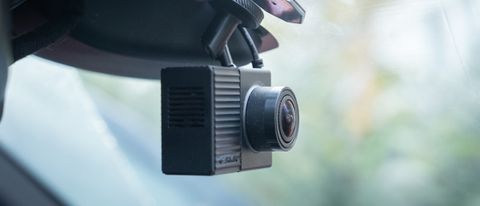The Garmin Tandem is a dash cam that simultaneously records forwards and rearwards to capture a view of the road ahead, and of the driver and their passengers. It isn’t the sort of dash cam every motorist needs, but for taxi and ride-share drivers it could prove invaluable if a claim is ever made against them by a customer.
Resolution: 1440p (front), 720p (interior)
HDR: Yes (front only)
GPS: Yes
Voice control: Yes
Field of view: 180 degrees (front and interior)
Display: No
Battery: No
Parking mode: Yes (hardwiring required)
Dash cams with an interior view are nothing new – we have an entire buying guide dedicated to them – but since we’re such big fans of other Garmin dash cams, like the excellent 67W, we have high hopes for the Tandem.
The big feature is how the Tandem records in two directions at once, and how Garmin has managed to fit both sensors and lenses into such a compact body. Some of today’s dash cams take up a serious amount of windscreen real estate (looking at you, Nextbase iQ), so it’s impressive to see how small the Tandem is.
Another lesser-seen feature of the Tandem is how the lenses are both 180 degrees. Some other interior dash cams are this wide, but very few forward-facing sensors go much beyond 140 degrees. Other manufacturers argue that anything more causes distortion, and while that can be true, I’m glad to see 180 degrees from Garmin, since this means a dash cam that captures more of its surroundings.
Something else Garmin tends to get right is voice control. It works really well, in that it responds quickly and reacts reliably. It’s a useful way to mute the microphone or manually save a recording.

Garmin Dash Cam Tandem: Design & Handling
The Tandem looks and feels very similar to other Garmin dash cams. This is great news in our book because we think Garmin’s hardware design is among the very best. The matchbox-sized camera has just two buttons; one for muting the microphone and another for manually recording video (for when you see an incident but aren’t directly involved).
Then there’s a microSD card slot on the button, a microUSB port on the side and…that’s it. Nice and simple. The Tandem fits to the windscreen with the same mount as other Garmin dash cams, which uses a coin-sized magnet that sticks to the screen, and onto which a small plastic arm snaps into place. This then connects to the dash cam with a ball-and-socket joint that offers a fit that is as secure as it is adjustable.


Garmin Dash Cam Tandem: Performance
The Tandem is quick and easy to set up using Garmin’s Drive smartphone app. Or you can simply plug it in and leave everything on the default setting; there’s no requirement for you to create an account or ever actually use the app if you don’t want to.
The front-facing camera is great, with HDR and a 1440p resolution that produces high-quality video both day and night. Some 4K cameras produce even sharper, more detailed footage, but they (like the Nextbase iQ) tend to be more expensive.
Recordings are saved to the microSD card, and you can also have them automatically upload to the cloud via a Wi-Fi connection with your phone. This requires a subscription to Garmin’s Vault storage service, however.
The interior camera is less impressive since its resolution is just 720p. That’s still technically HD (just not Full HD), but for the price we had hoped for better, and really it should be at least 1080p. It also manages just 30 fps (same as the front camera), and lacks HDR.

All that said, automatic night vision helps to produce audible interior footage that is plenty sharp enough if it were ever needed as evidence – to help document an incident between a taxi driver and an unruly passenger, for example.
Lastly, there’s a parking mode. Like most other dash cams, this requires a hardwiring kit or Garmin’s OBD cable to power the dash cam after the car has been switched off. If installed as such, the Tandem switches to a low-power state, ready to spring into life and start recording the moment a parking prang is detected by its g-sensor.
Garmin Dash Cam Tandem: Final Verdict
If you're in the market for a dual-view dash cam, the Garmin Tandem is hard to ignore. Its compact size and simple but very effective windscreen mount are both excellent, while the front camera records impressive footage, and the voice control function works well.
We wish the interior camera was of higher quality, but it still manages to produce usable footage in any lighting condition, and when it comes to interior views we value the wide,180-degree lens over the number of pixels.


